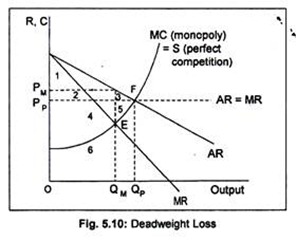Get the answer of: Is Monopoly Business Socially Harmful?
Now we intend to investigate the social costs of monopoly power.
In other words:
Is monopoly business socially harmful? A monopoly business results in an inefficient production. On the other hand, perfect competition leads to social efficiency. Socially efficient production is possible under perfect competition since price equals marginal cost (P = MC).
ADVERTISEMENTS:
But under monopoly, a lower level of output is produced since price exceeds marginal cost (P > MC). This results in lower output and higher price than the perfectly competitive industry. Fig. 5.10 shows that monopoly output QM is smaller than competitive output QP and monopoly price PM is higher than competitive price PP.
Economists are interested in showing the volume of waste, i.e., negative excess capacity from inefficient production. As a result, both consumers and producers suffer from losses. Economists call this ‘loss in welfare’ under monopoly the ‘deadweight loss’.
To measure the size of deadweight loss resulting deviations from competitive equilibrium, economists measure the concepts of consumer surplus and producer surplus— welfare becomes higher if consumer and producer surpluses are retained. There occurs a loss in welfare under monopoly when both consumer and producer lose surpluses. This loss of surplus in monopoly is called deadweight loss.
Consumer surplus measures the excess of benefits (i.e., total utility) from the consumption of a commodity over the price (i.e., total money expenditure) of the good. The sum of all individual consumer surpluses gives us total consumer surplus. It is measured by the area below the (market) demand curve and above the market price.
ADVERTISEMENTS:
Producer surplus is another name for profit. It is defined as the difference between price received by a firm from the sale of goods (i.e., total revenue) and the marginal cost of production. Producer surplus of all producers is measured by the difference between the area above the supply curve and below the market price.
How does deadweight loss occur under monopoly can best be explained in terms of Fig. 5.10. For simplicity’s sake, we assume that the monopolist and the competitive firms have the same cost curves. In other words, what is MC to a monopolist is the supply curve of a competitive firm.
Our monopolist is in equilibrium at point E where MC = MR. The corresponding monopoly output is OQM and price is OPM. Under perfect competition, equilibrium occurs at point F. So the competitive output and price are OQP and OPP, respectively.
ADVERTISEMENTS:
Monopoly results in two kinds of losses: consumer surplus and producer surplus. Consumer surplus is the difference between the area below the AR curve or demand curve and above the market price. Or it is the difference between total utility obtained from consuming a product and total expenditure.
With OQM output produced under monopoly, total utility obtained is given by the areas 1 + 2 + 4 + 6 and total expenditure is given by the areas 2 + 4 + 6. Thus, consumer surplus = (1 + 2 + 4 + 6) – (2 + 4 + 6) = 1.
Producer surplus is the difference between the total revenue and total cost. Total revenue under monopoly is the areas 2 + 4 + 6 while total cost is the area 6.
Thus,
producer surplus = (2 + 4 + 6) – (6) = 2 + 4.
Total surplus under monopoly is thus the areas 1 + 2 + 4. But, since monopoly price is higher than competitive price, consumers buy less and lose areas 2 + 3. On the other hand, a monopoly seller enjoys gain and suffers from losses due to higher price. The seller gains area 2 but looses area 5.
The net change in consumer and producer surplus is thus:
(– 2 – 3) + (2 – 5) = – 3 – 5
It is the monopoly that has resulted in a loss of aggregate consumer and producer surplus. This loss in surplus is called deadweight loss. The deadweight loss is the social cost of inefficient production.
ADVERTISEMENTS:
Some economists argue “…that these costs of monopoly are relatively small, amounting to perhaps 3 per cent of the monopolist’s output value. Others believe the losses from restricting output are higher.”
